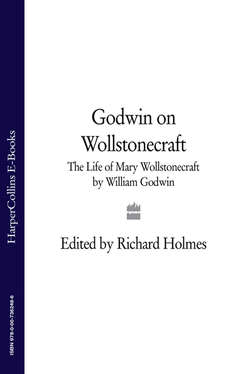Читать книгу Godwin on Wollstonecraft: The Life of Mary Wollstonecraft by William Godwin - William Godwin - Страница 8
5
ОглавлениеSome two centuries later its is still possible to find the Memoirs shocking, and to disagree about the picture its draws of Wollstonecraft. Many feminist critics believe that it miscast her as a Romantic heroine, and fatally undervalued her intellectual powers. Most of her modern biographers freely use Godwin as wonderful source material, but condemn him as a hopelessly biased witness.
Even an outstandingly perceptive and measured writer like Claire Tomalin is uneasy about the effect of his work. ‘In their own way, even the Memoirs had diminished and distorted Mary’s real importance: by minimizing her claim to be taken seriously for her ideas, and presenting her instead as a female Werther, a romantic and tragic heroine, he may have been giving the truth as he wanted to see it, but was very far from serving the cause she had believed in. He made no attempt to discuss her intellectual development, and he was unwilling to consider the validity of her feminist ideas in any detail.’ (Tomalin, 1974)
This has weight, and is curiously close to the criticism originally made by the Analytical Review in 1798. But it has to be set, for example, against Godwin’s extended analysis and celebration of the significance of The Rights of Woman in Chapter 6. ‘Never did any author enter into a cause, with more ardent desire to be found, not a flourishing and empty declaimer, but an effectual champion…When we consider the importance of its doctrines, and the eminence of genius it displays, it seems not very improbable that [her book] will be read as long as the English language endures…’
Much criticism has also been directed against Godwin’s attempt at the very end of his biography, to summarize Mary’s ‘intellectual character’, and apparently draw a ‘gendered’ distinction between masculine and feminine intelligence. He contrasts his own cool rational delight in ‘logic and metaphysical distinction’, with her strong, warm emotional instincts and ‘taste for the picturesque’. (Chapter 10). This is easily ridiculed. But it is overlooked that Godwin, the faithful biographer, was actually paraphrasing one of Wollstonecraft’s own letters to him of August 1796. This is what Mary herself wrote on the subject.
Our imaginations have been rather differently employed – I am more a painter than you – I like to tell the truth, my taste for the picturesque has been more cultivated…My affections have been more exercised than yours, I believe, and my senses are quick, without the aid of fancy – yet tenderness always prevails, which inclines me to be angry with myself when, I do not animate and please those I love.
But the problem of the intimate biography which seems to violate certain codes of family loyalty and trust is still with us. Thirty years ago, Nigel Nicolson’s Portrait of a Marriage (1973), which revealed his mother Vita Sackville-West’s lesbian relationships, and his father’s homosexual ones, raised such questions. More recently, John Bailey’s account of his wife Iris Murdoch’s relentless destruction by Alzheimer’s disease, in Iris (1999), left many readers and reviewers deeply troubled by such revelations. Yet both these are fine books, and it seems possible that biography as a form is destined to challenge conventions of silence and ignorance.
One also has to consider the historical effect of such a powerful biography is a more oblique way. The fact, for example, that Mary’s life inspired so many Romantic novels, suggests Godwin had also made her something of a legendary figure. The emotional intensity of Marianne Dashwood in Sense and Sensibility, the novel which Jane Austen originally drafted at just this time (1797-8), might owe more than we suspect to Mary’s example.
Her outrageous or comic persona still contained heroic or exemplary possibilities. Harriet Freke might yet be reincarnated as J.S. Mill’s feminist companion Harriet Taylor, who was largely responsible for Mill’s great work On the Subjection of Women (1869). Wollstonecraft was championed by the reformer Robert Owen, and written about admiringly in a little-known essay by George Eliot. In 1885 she was one of the first figures to be included in the Eminent Woman Series, alongside Elizabeth Fry and Mary Lamb.
So there is an alternative tradition in which Mary Wollstonecraft’s reputation. runs underground through the 19th century, especially among women writers. It has been traced in a recent classic of feminist scholarship, Wollstonecraft’s Daughters, 1996. (See Further Reading)
It eventually resurfaces in the superb essay by Virginia Woolf of 1932. Inspired by the tone of the Memoirs, she describes Gilbert Imlay not as a villain but as a laughable fool: ‘tickling for minnows he hooked a dolphin’. She celebrates Mary’s relationship with Godwin as the ‘most fruitful experiment’ of her life. Their marriage was ‘an experiment, as Mary’s life had been an experiment from the start, an attempt to make human conventions conform more closely to human needs.’ In a striking and prophetic conclusion, Woolf sees the story and example of Mary’s tempestuous life blossoming again among her contemporaries. ‘She is alive and active, she argues and experiments, we hear her voice and trace her influence even now among the living.’.
